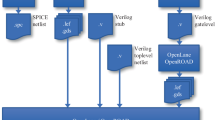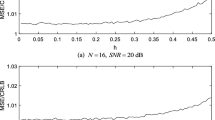Abstract
An adaptive equalizer for ATSC standard HDTV receivers is developed and implemented in VLSI. This equalizer is based on the G-pseudo algorithm that combines the advantages of the decision directed and blind algorithms. It also conducts ghost cancellation for the reception of NTSC analog TV signals. A programmable error calculation unit is employed for a flexible implementation of several equalization algorithms. The filter coefficients have a long internal word-length for a satisfactory operation in the blind adaptation mode, but only parts of them are used for output calculation to reduce the hardware complexity. The performance of the system for seven GA reference channels is evaluated according to the adaptation algorithms, the number of delays for the adaptation, and the word-length of the filter coefficients. The chip area and power consumption according to the time multiplexing ratio are estimated.
Similar content being viewed by others
References
ATSC Digital Television Standard (A/53), and Guide to the Use of the ATSC Digital Television Standard (A/54), Sep. 1995.
Y. Sato, “A Method of Self-Recovering Equalization for Multilevel Amplitude Modulation Systems,” IEEE Trans. Comm., vol. COM-23, no. 7, 1975, pp. 679–682.
A. Benveniste and M. Goursat, “Blind Equalizers,” IEEE Trans. on Communications, vol. COM-32, no. 8, 1984.
N. Deshpande, “Fast Recovery Equalization Techniques for DTV Signals,” IEEE Trans. on Broadcasting, vol. 43, no. 4, 1997.
E. Hwang and W. Sung, “Blind Equalization Algorithms for Comb-Filtered Digital TV Signal,” Electronics Letters, vol. 35, no. 21, 1999, pp. 1798–1799.
Grand Alliance System Test Procedures, ACATS, Mar. 1995.
B. Edwards, A. Corry, N. Weste, and C. Greenberg, “A Single-Chip Video Ghost Canceller,” IEEE J. Solid-state Circuits, vol. 28, no. 3, 1993, pp. 379–383.
S.S. Chae, S.B. Pan, G.H. Lee, R.H. Park, and B.-U. Lee, “Hardware Architectures of Adaptive Equalizers for the HDTV Receiver,” IEEE Trans. Signal Processing, vol. 46, no. 2, 1998, pp. 391–404.
J. Oh, Y. Chang, K. Ha, S. Jung, and J. Kim, “A Single VSB/QAM/QPSK IC for ATSC and OpenCable™ Digital Terminals,” IEEE Tr. Consumer Electronics, vol. 47, no. 3, 2001, pp. 443–449.
Design Compiler Reference Manual: Constraints and Timing, Synopsys Inc., 1998.
G10-p cell-based ASIC Products Data Book, LSI Logic Co., 1998.
Author information
Authors and Affiliations
Corresponding author
Additional information
Wonyong Sung received the B.S. degree in electronic engineering from the Seoul National University in 1978, the M.S. degree in electrical engineering from the Korea Advanced Institute of Science and Technology (KAIST) in 1980, and the Ph.D. degree in electrical and computer engineering from the University of California, Santa Barbara, in 1987.
From 1980 to 1983, he worked at the Central Research Laboratory of the Gold Star (currently LG electronics) in Korea. During his Ph.D. study, he developed parallel processing algorithms, vector and multiprocessor implementation, and low-complexity FIR filter design. He has been a member of the faculty of the Seoul National University since 1989. From May of 1993 to June of 1994, he consulted the Alta Group for the development of the Fixed Point Optimizer, automatic word-length determination and scaling software. From January of 1998 to December of 1999, he worked as a chief of the SEED (System Engineering and Design center) in Seoul National University. He was an associate editor of the IEEE Tr. Circuits and Systems II from 2000 to 2001, is a design and implementation technical committee member of the IEEE Signal Processing Society, and is a VLSI systems and application technical committee member of the IEEE Circuits and Systems Society. He was the general chair of the IEEE Workshop on Signal Processing Systems in 2003. He founded a venture company, Edumedia Technologies, in 2000, and has developed a handheld educational device for kids, SpeakingPartner, for mass production.
His major research interests are the development of fixed-point optimization tools, implementation of VLSI for digital signal processing, and development of multimedia software for handheld devices and VLIW digital signal processors.
Youngho Ahn received the B.S. and M.S. degrees in electronic engineering from Seoul National University, Seoul, Korea, in 1997 and 1999 respectively. From 1999 to 2000, he was with Samsung Electronics, Kyunggi-Do, Korea, where he was involved in the ASIC design and development of ATSC digital television receivers. Since 2001, he has been with GCT Semiconductor, Inc., where he works in the communications IC design group. His research interests include wireless communications and ASIC design of communications systems.
Eunjoo Hwang was born in Taegu, Korea on April 7, 1974. She received the B.S and M.S degrees in electrical engineering from Seoul National University in 1997 and 1999, respectively. Currently, she works for Silicon Image in Sunnyvale, California, USA as a digital circuit design engineer. Her research interests include blind equalization, joint timing recovery algorithm and storage network design.
Rights and permissions
About this article
Cite this article
Sung, W., Ahn, Y. & Hwang, E. VLSI Implementation of An Adaptive Equalizer for ATSC Digital TV Receivers. J VLSI Sign Process Syst Sign Image Video Technol 40, 301–310 (2005). https://doi.org/10.1007/s11265-005-5266-2
Published:
Issue Date:
DOI: https://doi.org/10.1007/s11265-005-5266-2




